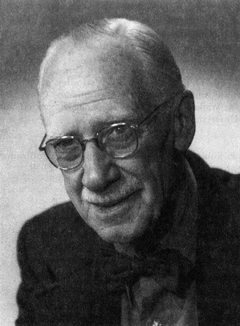Kenneth Stewart Cole facts for kids
Quick facts for kids
Kenneth Stewart Cole
|
|
|---|---|
 |
|
| Born | July 10, 1900 |
| Died | April 18, 1984 (aged 83) |
| Alma mater | Oberlin College Cornell University |
| Known for | Cole–Cole equation Voltage clamp |
| Spouse(s) | Elizabeth Evans Roberts |
| Children | 2 |
| Awards | ForMemRS (1972) National Medal of Science (1967) Guggenheim Fellowship (1941) |
| Scientific career | |
| Fields | Biophysics |
Kenneth Stewart Cole (born July 10, 1900 – died April 18, 1984) was an American biophysicist. A biophysicist is a scientist who uses the rules of physics to study living things. His friends and colleagues called him a "pioneer" because he was one of the first to use ideas from physics to understand how our bodies work. He even received the National Medal of Science in 1967, which is one of the highest science awards in the United States!
Contents
Kenneth Cole's Life Story
Kenneth Cole was born on July 10, 1900, in Ithaca, New York. His father, Charles Nelson Cole, taught Latin at Cornell University. Kenneth also had a younger brother, Robert H. Cole, and they stayed very close throughout their lives. They even wrote four science papers together!
In 1902, Kenneth's family moved to Oberlin, Ohio. His father started working at Oberlin College and later became the Dean there. Kenneth went to Oberlin College too, graduating in 1922. He then earned his Ph.D. in physics from Cornell University in 1926. During his summers, he worked at the General Electric laboratory.
In 1932, Kenneth married Elizabeth Evans Roberts. She was a lawyer who later worked on civil rights issues. In 1957, she joined the staff of the United States Commission on Civil Rights.
Kenneth worked at Columbia University from 1937 to 1946. He also spent time at the Presbyterian Hospital, the Guggenheim Foundation for Advanced Study at Princeton University, and the University of Chicago.
From 1949 to 1954, he was a technical director at the Naval Medicine Research Institute. After that, he became the chief of the biophysics laboratory at the National Institute of Neurological Diseases and Blindness.
Understanding How Nerves Work
Kenneth Cole made big discoveries that helped scientists understand how nerves send signals. This led to the "sodium theory" of nerve transmission. This theory later helped Alan L. Hodgkin and Andrew F. Huxley win a Nobel Prizes in 1963!
Because of his important work, Kenneth Cole received many honors:
- He became a Fellow of the American Physical Society in 1931.
- He joined the National Academy of Sciences in 1956.
- He became a Fellow of the American Academy of Arts and Sciences in 1964.
- In 1967, he received the National Medal of Science. The award said that because of his work, "we know far more about how the nervous system functions."
- In 1972, he became a member of the Royal Society of London.
Today, the Biophysical Society gives out the Kenneth S. Cole medal to scientists who study cell membranes, honoring his legacy.
In 1980, he became a professor at the Scripps Institute of Oceanography in San Diego. Kenneth and Elizabeth had two children, a son named Roger and a daughter named Sarah.
Kenneth Stewart Cole passed away on April 18, 1984, in La Jolla, California.
Electrical Properties of Living Tissues
Kenneth Cole was very interested in how living tissues, like those in our bodies, act like tiny electrical circuits. He found that tissues have both resistance (which slows down electricity) and capacitance (which stores electrical energy).
He developed a way to describe these electrical properties using a special formula. This formula, called the Cole–Cole model, helps scientists understand how electricity moves through different parts of the body. It has been used for over 60 years to study many types of tissues.
In the 1930s and 1940s, Kenneth Cole did many experiments to study the electrical properties of living tissues. He studied things like Nitella (a type of algae), frog eggs, and most famously, the squid giant axon. The squid giant axon is a very large nerve cell that was perfect for studying how nerve signals travel. His work helped us understand how these electrical signals are sent throughout our nervous system.
See also
- Action potential
- Cable theory
- Dendrite
Images for kids


